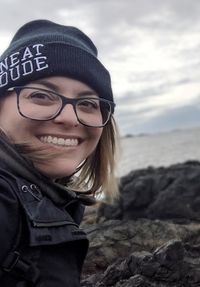CAZypedia needs your help! We have many unassigned GH, PL, CE, AA, GT, and CBM pages in need of Authors and Responsible Curators.
Scientists at all career stages, including students, are welcome to contribute to CAZypedia. Read more here, and in the 10th anniversary article in Glycobiology.
New to the CAZy classification? Read this first.
*
Consider attending the 15th Carbohydrate Bioengineering Meeting in Ghent, 5-8 May 2024.
User:Julie Grondin
Julie Grondin obtained her PhD in 2009 with Dr. Steven Smith at Queen's University (Kingston, ON, Canada), where she used NMR, XRC, and SAXS toward the structural characterization of large multi-modular GHs from the human gut pathogen Clostridium perfringens. From 2014-2017, she worked in Wade Abbott's group at Agriculture and Agri-Food Canada (Lethbridge, AB, Canada) as a postdoctoral fellow, where she designed nutrient utilization, inducible expression, metabolic selection, and reverse genetics systems into the human gut symbiont Bacteroides thetaiotaomicron. She is currently a post-doctoral fellow in Harry Brumer's group at the Michael Smith Laboratories at the University of British Columbia (Vancouver, BC, Canada).
Julie has contributed to the structural and functional characterization of several CBM32 from the multi-modular Clostridium perfringens GH84 and GH31 [1, 2, 3], as well as the characterization of full-length CpGH84A (unpublished), and the agarose utilization system in Bacteroides uniformis [4]. She was also involved in the development of a carbohydrate-inducible heterologous expression system in Bacteroides thetaiotaomicron [5].
- Grondin JM, Chitayat S, Ficko-Blean E, Boraston AB, and Smith SP. (2012). 1H, 15N and 13C backbone and side-chain resonance assignments of a family 32 carbohydrate-binding module from the Clostridium perfringens NagH. Biomol NMR Assign. 2012;6(2):139-42. DOI:10.1007/s12104-011-9342-1 |
- Grondin JM, Chitayat S, Ficko-Blean E, Houliston S, Arrowsmith CH, Boraston AB, and Smith SP. (2014). An unusual mode of galactose recognition by a family 32 carbohydrate-binding module. J Mol Biol. 2014;426(4):869-80. DOI:10.1016/j.jmb.2013.11.029 |
- Grondin JM, Duan D, Kirlin AC, Abe KT, Chitayat S, Spencer HL, Spencer C, Campigotto A, Houliston S, Arrowsmith CH, Allingham JS, Boraston AB, and Smith SP. (2017). Diverse modes of galacto-specific carbohydrate recognition by a family 31 glycoside hydrolase from Clostridium perfringens. PLoS One. 2017;12(2):e0171606. DOI:10.1371/journal.pone.0171606 |
- Pluvinage B, Grondin JM, Amundsen C, Klassen L, Moote PE, Xiao Y, Thomas D, Pudlo NA, Anele A, Martens EC, Inglis GD, Uwiera RER, Boraston AB, and Abbott DW. (2018). Molecular basis of an agarose metabolic pathway acquired by a human intestinal symbiont. Nat Commun. 2018;9(1):1043. DOI:10.1038/s41467-018-03366-x |
- Jones DR, Smith MB, McLean R, Grondin JM, Amundsen CR, Inglis GD, Selinger B, and Abbott DW. (2019). Engineering dual-glycan responsive expression systems for tunable production of heterologous proteins in Bacteroides thetaiotaomicron. Sci Rep. 2019;9(1):17400. DOI:10.1038/s41598-019-53726-w |
